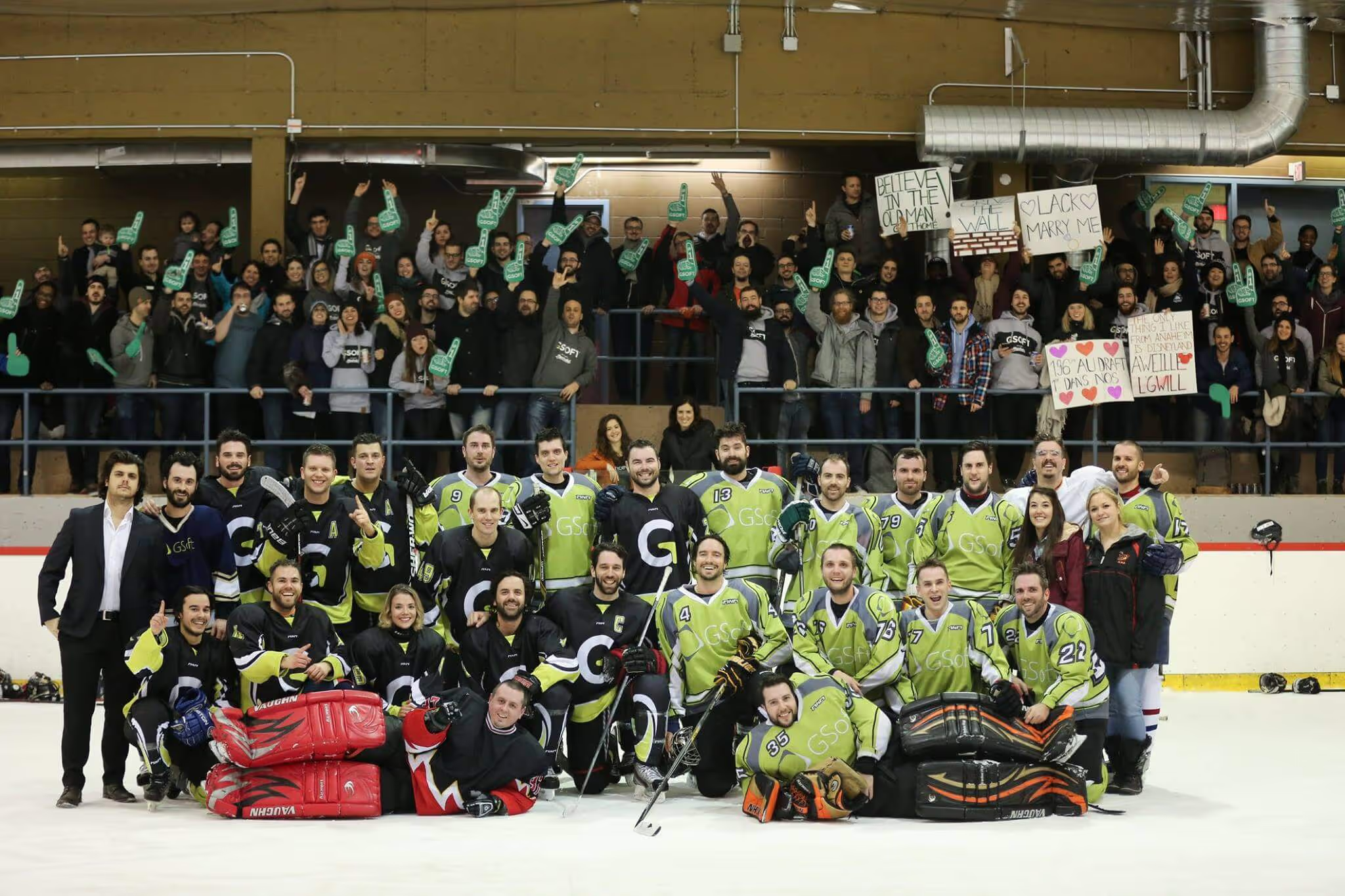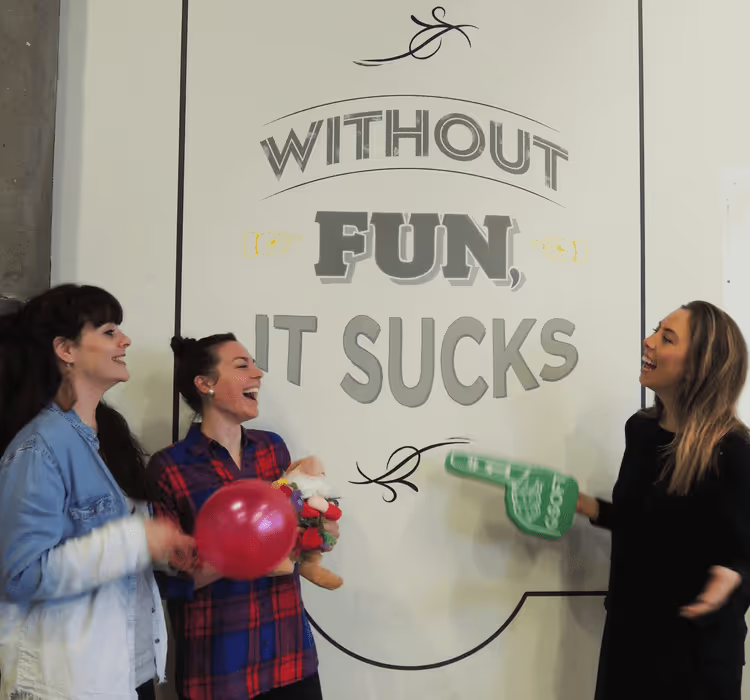Why a fun company culture is good for business

Discover Workleap Officevibe's benchmark report on 12 key employee engagement metrics

It seems counterintuitive to suggest that work should be fun, right? Our whole lives we’ve been taught the “work hard, play hard” dichotomy. But why can’t work be fun in and of itself?
People rarely succeed unless they have fun in what they are doing.
Dale Carnegie
Fun company cultures are the best way to keep your employees and attract new ones. And while having fun perks like unlimited vacation is not a bad way to stimulate a fun culture, it doesn't always need to cost you. A fun culture stems from the energy and the vibe of your workplace, and it's up to the manager to set the tone for their team.
What is company culture?
Company culture is essentially the personality, or the identity, of a company. Every company has a company culture, whether you intend to or not, but the difference is that great companies will cultivate theirs into being unique to their organization. Just like you’d ideally want a person you spend a lot of time with to be friendly, approachable, special and pleasant, the same goes for work - especially since that’s where people tend to spend most of their time. People don’t just work to earn a paycheck.
This recent article from Harvard Business Review explains that:
One of the most striking results we’ve found is that, across all income levels, the top predictor of workplace satisfaction is not pay: It is the culture and values of the organization, followed closely by the quality of senior leadership and the career opportunities at the company.
Compensating your employees properly is important, of course, but there’s so much more to work than just money. People are interested in enjoying their day to day, not just profiting from it.
Having a fun company culture is good for business
A fun, positive company culture is without a doubt good for business. Here are two reasons why:
1. It helps engage your employees
Engaged employees are more productive. Having a great company culture makes employees want to show up to work every day and do their best. It keeps them enthusiastic about their tasks and appreciative of all you do to ensure the workplace environment is enjoyable.
2. It helps attract new talent
When an employee loves where they work, they naturally become company ambassadors and help to organically promote your company, helping to attract new talent and promote the enterprise from the inside out.
This is why measuring your company’s Employee Net Promoter Score (eNPS) is important. Finding out how likely they are to recommend your company as a place to work will help you understand what areas you can work on improving.
I don't think of work as work and play as play, it's all living.
Richard Branson
Fun company culture examples
Here are some great examples of positive and fun company cultures.
Warby Parker
- They make sure that there’s always an event coming up, so employees have something to look forward to.
- Managers send random employees out to have lunch together to get to know everyone on their team.
- They hold meetings on rooftops to keep it interesting.
- They get free meals delivered to the office.
- Unlimited vacations (for some).
- They offer mid-day yoga classes.
NextJump
- They built a free on-site gym for their employees, but only 5-10% of the company used it, so they created a fitness challenge that offered winning employees $1000.
HVAC.com
- They encourage employees to get out of the office on international mission trips, volunteer trips, organize summer cookouts supporting local causes, and even just go to museums.
Not every company can offer big fun perks like these, and that’s ok. A big part of having a fun company culture is just in the attitude that managers bring to the team.
This article, which discusses Richard Branson’s fun-tinted view on work and life, says it best:
Experiment in your workplace, get creative, laugh out loud and encourage everyone to have some fun. You don’t have to be Zappos, Google, Facebook or Virgin to build fun into your culture. Well-placed humour in an office environment puts others at ease. It raises the energy, encourages innovation and undoubtedly improves productivity.
Activities to help build a fun company culture
Organize office challenges
Organizing challenges within the office is a great way to engage employees through your company culture. This can pertain to the work itself, meaning creating some sort of friendly competition surrounding an initiative, or it can pertain to non-work-related challenges that the team participates in together.
For example, at Officevibe's parent company, each employee is gifted a FitBit as part of their onboarding welcome, and we compete in a challenge called Fit League to see who can reach the highest number of steps.

As another example, we just had our Winter Classic Hockey Tournament, which brought a ton of team spirit, camaraderie, and a bit of healthy competition to the workplace.

These challenges keep people active, engaged, and, of course - having fun!
Encourage eating lunch as a team
It’s so easy to spend all day at your desk, staring at your screen, but if an office environment is overly stressful and all employees do is work, day in and day out without a pleasant reprieve, they risk becoming disengaged.
As humans, we need socialization - it’s what breaks up the day and makes work fun. Ensure that you and your employees eat lunch as often as possible as a team. It’s important for our minds to take a break, and it’s a great way to get to know your team and for them to see you as more than a “boss.”
Get out of the office
Remember school field trips? How exciting it was to leave school for a few hours. Didn’t it make you appreciate your teachers so much more?
Work isn’t a prison - organize some off-site events. Be it drinks after work, lunch at a nearby restaurant, a professional development initiative, or even an offsite work day in a co-working space like WeWork.
For example, we have a Karaoke night coming up. It’s sure to be a memory-filled evening, and that outside fun trickles back into the Officevibe because, as a team, we are bonding and solidifying relationships.
Organized group exercise is another great way to get out of the office mid-day while doing something that will help increase your energy levels for the end-of-day sprint. Even just a group walk at lunchtime.
Celebrate milestones and wins
This is one of the most important ways to promote a positive, fun company culture, and it’s embedded in the tenets of employee engagement. Employees need and deserve constant recognition for their hard work to want to continue working hard for your company.
It’s called the Progress Principle, and it focuses on the power of small wins:
Of all the things that can boost inner work life, the most important is making progress in meaningful work.
Celebrating individual wins should happen daily.
For example, we have a “Kudos” channel in our Slack community that publicly allows employees and managers to commend one another on a job well done. This channel is active all day with great positive energy.
You can also celebrate company wins on a larger scale- be it regarding sales, the launch of a new initiative, the post-mortem of a successfully completed one, receiving amazing press, etc.
Celebrate! Company-wide. Together.
When we have a “big win,” we celebrate with champagne!
Imagine all the positive energy that is built up throughout the week when no good job goes unnoticed.
Create a fun office space
Depending on your company culture, you can interpret this as you like, but I’ll give you a glimpse into our office so you have an idea of what a fun office might look like.
We have long hallways, so we use skateboards and scooters.
We have a ping pong table - great to blow off steam between tasks (we also have competitions a few times a year).

We have an in-house café with our own barista - which promotes a really nice social gathering place, especially in the morning when we all have a cup of joe together.

We have a skateboard ramp in the office.

And, we have a huge sign on our wall that reads: "Without Fun, It Sucks"

And it’s the truth. Work, without fun, does kind of suck. Knowing that management realizes this and wants our days to be as pleasant as possible is what makes employees go above and beyond for the company.
Office ice breaker games
Fun doesn't need to cost anything. Icebreaker games are free and a great way to interject laughter into the day. There are tons of activities you can do with your team to increase bonding and make the day a little more fun.
Looking for more ways to build a fun company culture? Check out this list of 40+ fun employee engagement activities.
How Officevibe helps make your team culture come alive
Our tool works for any type of work dynamic — on-site, hybrid, you name it — empowering managers and employees to bring out the best of their teams and themselves.
Officevibe empowers team leaders with features like:
Manager templates: Through our template hub, you can save time and better navigate any scenario with our 1-on-1 meeting and employee survey templates that experts have designed.
Team hub: Benefit from a more comprehensive understanding of your team via a centralized view of engagement metrics, important milestones, and your managerial activities.
Conversation Engine: Team building doesn’t only occur during formal meetings. Our platform provides dozens of purposeful conversation starters to keep culture nurturing daily.
Feedback guidance: We’re here to ensure you feel confident in answering sensitive feedback skillfully thanks to provided expert advice.
Manager hub: A one-stop shop for action items and reminders to help you stay on top of your duties and accountable to your team no matter how busy your work life gets.
Use Officevibe to get a pulse on your team culture, keep an eye on morale, and set up meaningful 1-on-1s to stay connected, no matter where you work.
Give HR and managers the clarity, confidence, and connection to lead better every day.


%20(1).png)


.png)
.png)








